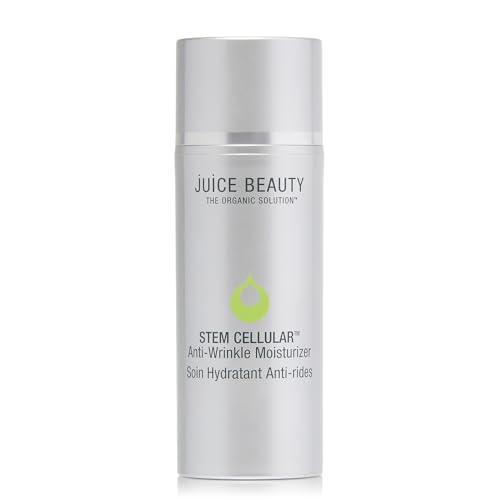
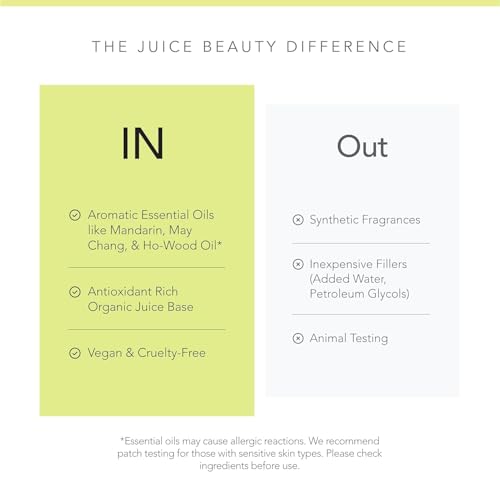
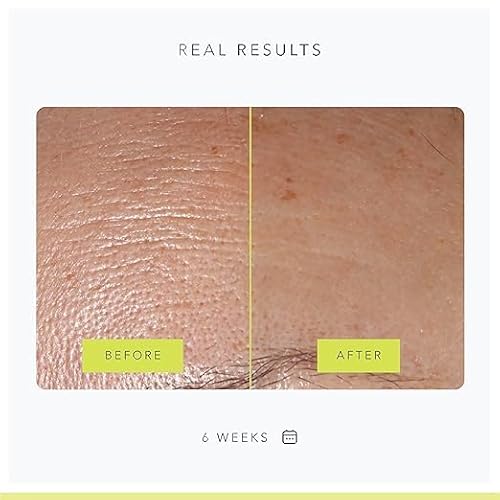
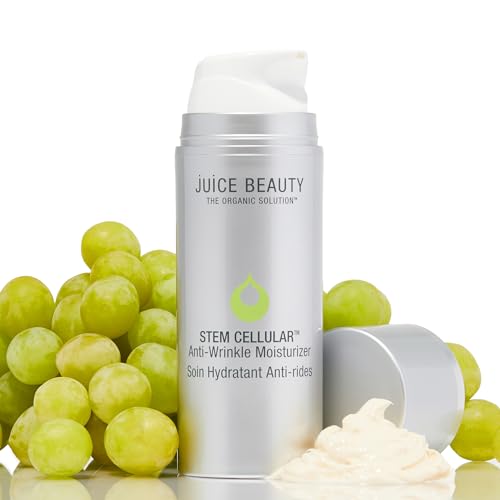
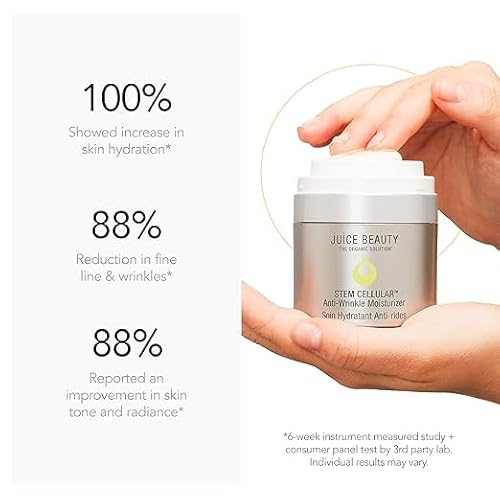
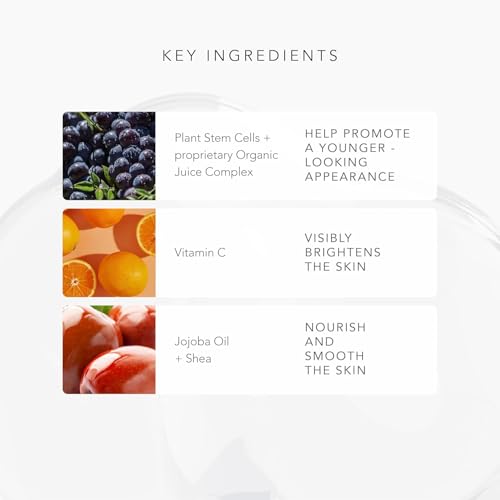
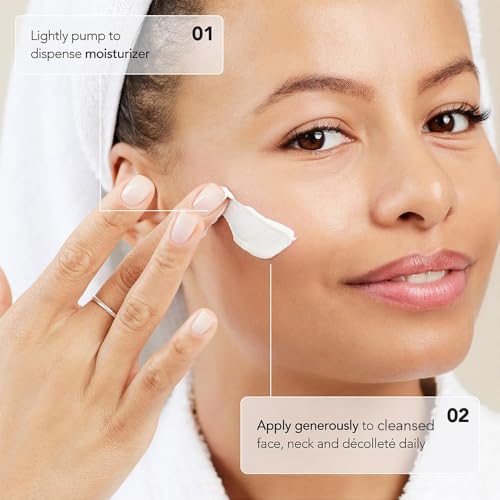
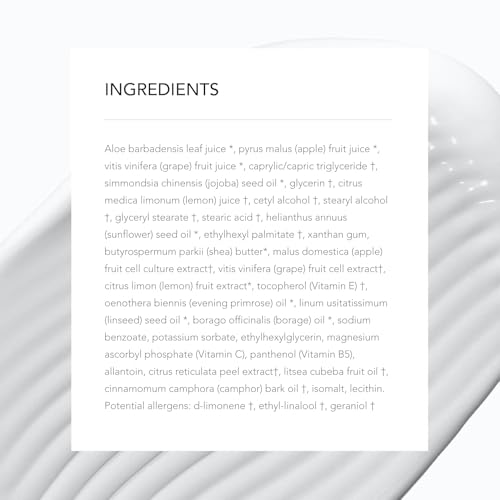
Juice Beauty Moisturizer - Anti-Wrinkle Hydration with Plant Stem Cells & Vitamin C - 4 fl oz


Citrus Limon (Lemon) Juice
High RiskCitrus limon (lemon) juice is derived from the fruit of the lemon tree and is commonly used as a flavoring agent and preservative in various food and cosmetic products. It contains citric acid, which acts as a natural preservative and antioxidant.
Sustai Insights
Lemon juice provides functional benefits, including acting as a natural preservative and flavor enhancer. However, it has a high allergenic potential, which may lead to skin irritation or hypersensitivity in some individuals. Environmental risks include potential bioaccumulation and pollutant effects. Regulatory agencies have noted some use restrictions, suggesting caution in formulation. Overall, the risk level associated with lemon juice is assessed as high, warranting careful consideration in product development and usage.
Geraniol
High RiskGeraniol is a naturally occurring scent ingredient commonly found in essential oils from plants such as geraniums and lemongrass. It is primarily used for its pleasant floral aroma in perfumes, cosmetics, and household products.
Sustai Insights
Geraniol serves as a fragrance component and offers a natural option for scenting products. However, it has a high allergenic potential and may cause skin irritation in sensitive individuals. While it is considered low risk for carcinogenicity and reproductive toxicity, regulatory bodies have placed restrictions on its use due to allergenic concerns. Overall, the assessment reflects a high-risk level, particularly for those prone to allergies, highlighting the need for caution in its application.
Sodium Benzoate
Medium RiskSodium benzoate is a preservative commonly used in food and cosmetic products to prevent microbial growth and extend shelf life. It is derived from benzoic acid and is effective at low concentrations, often used in acidic environments like beverages and condiments.
Sustai Insights
Sodium benzoate serves effectively as a preservative, contributing to product stability and safety. It is generally recognized as safe with low concerns for carcinogenicity, allergies, and reproductive toxicity, though it faces moderate use restrictions in some regions. Environmental risks include its potential as a pollutant, but it does not bioaccumulate significantly. Regulatory bodies have issued advisories regarding its concentration in products. Overall, the risk level is assessed as medium, with safe usage practices recommended. Alternatives such as potassium sorbate may provide similar benefits with potentially lower restrictions.
Lecithin
Medium RiskLecithin is a naturally occurring lipid found in various plant and animal tissues, primarily composed of phospholipids. It serves as an emulsifier, stabilizing mixtures of oil and water, and is commonly used in food, cosmetics, and pharmaceuticals to improve texture and extend shelf life.
Sustai Insights
Lecithin provides functional benefits as an effective emulsifier and stabilizer, enhancing product texture while being sustainably sourced from natural origins. Health risks are generally low, with moderate concerns regarding allergies and immunotoxicity but minimal cancer or reproductive toxicity risks. Environmental hazards are limited, and it is not classified as a pollutant. Regulatory bodies impose few restrictions. Overall, lecithin presents a medium risk, suggesting caution in usage, especially for sensitive individuals. Alternatives include sunflower lecithin or other plant-based emulsifiers that may offer similar benefits with reduced allergenic potential.
Potassium Sorbate
Medium RiskPotassium sorbate is a potassium salt of sorbic acid, primarily used as a preservative in food and cosmetic products. It inhibits the growth of molds, yeast, and some bacteria, extending the shelf life of products. It is commonly found in various formulations due to its effectiveness and low toxicity.
Sustai Insights
Potassium sorbate serves as an effective preservative, preventing microbial growth in food and cosmetic products, which is vital for safety and longevity. Although it has a low risk of carcinogenicity and developmental toxicity, there is a moderate concern regarding allergies and immunotoxicity. Environmentally, it poses minimal risks as it is not significantly bioaccumulative. Regulatory agencies have verified its use, although some products may face restrictions. Overall, it is assessed as a medium risk ingredient, with safe usage practices recommended, and alternatives such as natural preservatives could be considered.
Isomalt
Low RiskIsomalt is a mixture of polysaccharides produced from sucrose, primarily used as a sugar substitute in various food and cosmetic products due to its functional properties such as sweetness and stability. It is often valued for its lower caloric content compared to traditional sugars.
Sustai Insights
Isomalt serves effectively as a sweetener and bulking agent, contributing to product texture and flavor without the high caloric content of sugar. It is considered low-risk concerning health effects, with minimal concerns regarding carcinogenicity, allergies, or reproductive toxicity. Environmentally, isomalt is not classified as a significant pollutant and poses low bioaccumulation risk. While regulatory bodies do not impose strict limitations, it is noted that certain formulations should avoid excess isomalt. Overall, isomalt presents a low-risk profile, making it a suitable choice in formulations.
Pyrus Malus (Apple) Fruit
Low RiskPyrus malus (apple) fruit is the fruit of the apple tree, commonly used in cosmetic formulations. It serves various functions, including acting as a moisturizer and providing antioxidant properties due to its natural compounds.
Sustai Insights
Pyrus malus (apple) fruit offers functional benefits such as moisturizing and antioxidant effects, contributing to skin health. It is sustainably sourced and poses low health risks, with minimal concerns regarding carcinogenicity, allergenic potential, or developmental toxicity. Environmental impacts are also low. Regulatory bodies do not impose significant restrictions on its use, classifying it as low risk overall. Safe usage practices include adhering to recommended concentrations in product formulations. Alternatives like other fruit extracts may provide similar benefits with comparable safety profiles.
Vitis Vinifera (Grape) Fruit Cell Extract
Low RiskVitis vinifera (grape) fruit cell extract is derived from grape cells and is commonly used in cosmetic formulations for its moisturizing and antioxidant properties. It is known for its potential to promote skin health and is often included in products aimed at improving skin texture and appearance.
Sustai Insights
This ingredient offers several functional benefits, including hydration and antioxidant protection, which can enhance skin health. It is generally considered safe with a low risk of health concerns, including carcinogenicity and allergies. There are no significant environmental hazards associated with its use, and it is not subject to regulatory restrictions. However, users should practice safe application methods. Alternatives may include other plant extracts known for similar benefits, but overall, the ingredient's risk level is categorized as low.
Helianthus Annuus (Sunflower) Seed
Low RiskHelianthus annuus (sunflower) seed is derived from the seeds of the sunflower plant and is commonly used in various cosmetic and personal care products. It serves primarily as an emollient and skin conditioning agent, providing moisture and enhancing the texture of formulations.
Sustai Insights
Helianthus annuus (sunflower) seed offers functional benefits, including skin conditioning and moisturizing properties, while being sustainably sourced and biodegradable. Health risks are minimal, with low concerns for carcinogenicity, allergies, and reproductive toxicity. Environmentally, it presents low risks of pollution or bioaccumulation. Regulatory assessments indicate no current restrictions. Overall, it is considered a low-risk ingredient, and safe usage practices should be maintained. Alternative ingredients may include other plant-based oils, but the sunflower seed oil remains a viable option.
Butyrospermum Parkii (Shea) Butter
Low RiskButyrospermum parkii (shea) butter is a vegetable fat derived from the nuts of the shea tree. It is commonly used in cosmetic formulations for its emollient properties, providing moisture and improving skin texture. Additionally, shea butter is known for its ability to enhance the stability of products and deliver a creamy texture.
Sustai Insights
Shea butter offers functional benefits as an effective moisturizer, enhancing skin barrier function and texture. It is sustainably sourced and biodegradable, contributing to eco-friendliness. Health-wise, it is associated with low risks for carcinogenicity, allergies, and reproductive toxicity. Environmental impacts are minimal, with no significant pollutant potential identified. Regulatory assessments indicate no current restrictions. Overall, the ingredient presents a low risk, making it a favorable choice in cosmetic formulations.
Caprylic Triglyceride
Low RiskCaprylic triglyceride is an ester derived from coconut oil and glycerin, commonly used in cosmetic formulations as an emollient, stabilizer, and skin-conditioning agent. It helps to improve the texture and spreadability of products while providing a lightweight, non-greasy feel.
Sustai Insights
Caprylic triglyceride offers functional benefits such as enhanced skin moisturization and improved formulation stability. It is generally regarded as safe, with low concerns regarding carcinogenicity, allergenic potential, and reproductive toxicity. Environmental impact is minimal, with no significant pollutant or bioaccumulative properties identified. Regulatory bodies have not issued warnings or restrictions. Overall, the risk level is low, making it a suitable ingredient in cosmetic products. Safe usage practices include adhering to recommended concentrations, and while there are alternatives, caprylic triglyceride remains a reliable choice.
Pyrus Malus (Apple)
Low RiskPyrus malus, commonly known as apple, is a fruit extract used in various cosmetic and personal care products for its moisturizing and antioxidant properties. It serves primarily as a natural fragrance and emollient, enhancing the sensory experience of formulations.
Sustai Insights
Pyrus malus offers functional benefits such as moisturizing and antioxidant effects. It is low in health risks, with minimal concerns regarding carcinogenicity, allergies, or reproductive toxicity. Environmentally, it does not contribute significantly to pollution or bioaccumulation. Regulatory assessments indicate no current restrictions on its use. Overall, it presents a low risk, making it a suitable ingredient in formulations.
Tocopherol, D Alpha
Low RiskTocopherol, specifically d-alpha tocopherol, is a naturally occurring form of Vitamin E. It is commonly used in cosmetic and personal care products primarily for its antioxidant properties, helping to protect formulations from oxidation and extend shelf life.
Sustai Insights
D-alpha tocopherol provides effective antioxidant benefits, contributing to product stability. It is sustainably sourced and generally regarded as safe, with low concerns regarding carcinogenicity, allergies, and reproductive toxicity. However, there are minor concerns about endocrine disruption. Regulatory bodies have not imposed significant restrictions, indicating low overall risk. Recommended usage practices include adhering to established safe concentration thresholds. Alternatives, such as other forms of Vitamin E or plant-based antioxidants, may also be considered.
Linum Usitatissimum (Linseed) Seed Oil
Low RiskLinum usitatissimum (linseed) seed oil is an oil extracted from the seeds of the flax plant, primarily used for its emollient properties in cosmetic formulations. It is known for its moisturizing and soothing effects on the skin, making it a common ingredient in various personal care products.
Sustai Insights
Linum usitatissimum (linseed) seed oil is recognized for its emollient benefits, providing hydration and skin barrier support. It is sustainably sourced and biodegradable. Health risks are minimal, with low concerns for carcinogenicity, allergies, or reproductive toxicity. Environmental risks are also low, with no significant pollutant or bioaccumulative potential. Regulatory bodies have not issued restrictions. Overall, it presents a low risk, making it a safe choice in formulations. For alternatives, consider other plant-based oils like jojoba or argan oil.
Stearyl Alcohol
Low RiskStearyl alcohol is a compound produced from the hydrogenation of stearic acid, commonly used in cosmetic formulations as an emulsifier and thickening agent. It helps stabilize products by blending oil and water phases, enhancing texture and consistency.
Sustai Insights
Stearyl alcohol provides functional benefits as an emulsifier and stabilizer, contributing to improved product texture. It is generally regarded as safe with low concerns for cancer, allergies, and reproductive toxicity. However, it may cause moderate skin, eye, or respiratory irritation. Regulatory bodies do not impose significant restrictions, indicating a low overall risk. While it poses minimal health and environmental hazards, caution is advised for sensitive individuals. Alternatives like cetyl alcohol or plant-based emulsifiers may offer safer options for formulators.
Vitis Vinifera (Grape)
Low RiskVitis vinifera (grape) is a plant material derived from grape seeds and skins, commonly used in cosmetic formulations for its antioxidant properties. It serves various functions, including as a moisturizer and skin-conditioning agent, contributing to the overall efficacy of personal care products.
Sustai Insights
Vitis vinifera (grape) offers functional benefits such as providing hydration and antioxidant effects, which can enhance skin health. It is sustainably sourced and generally regarded as safe with low concerns regarding carcinogenicity, allergies, and reproductive toxicity. However, minimal regulatory restrictions exist, and no significant environmental hazards are noted. Overall, the ingredient is considered low risk, making it a suitable option in cosmetic formulations without notable adverse health effects or environmental impact.
Borago Officinalis (Borage) Oil
Low RiskBorago officinalis (borage) oil is derived from the seeds of the borage plant, known for its high gamma-linolenic acid (GLA) content. It is commonly used in cosmetic and skincare products for its moisturizing properties, as well as in dietary supplements for its potential health benefits.
Sustai Insights
Borage oil provides functional benefits as a skin moisturizer and may support skin health due to its GLA content. It is biodegradable and can be sustainably sourced. Health risks are minimal, with low concerns for carcinogenicity, allergies, and reproductive toxicity. Environmental risks are also low, as it does not contribute significantly to pollution or bioaccumulation. No regulatory restrictions are noted. Overall, the ingredient is assessed to have a low risk level, making it a viable option in formulations.
Xanthan Gum
Low RiskXanthan gum is a polysaccharide, a sugar-based compound produced by the fermentation of glucose or sucrose. It is commonly used as a thickening agent and stabilizer in various food and cosmetic products due to its ability to improve texture and prevent ingredient separation.
Sustai Insights
Xanthan gum serves effectively as a thickener and stabilizer, enhancing product texture and consistency. It is biodegradable and typically derived from renewable sources, supporting sustainability efforts. Health risks are minimal, with low concerns regarding carcinogenicity, allergies, and reproductive toxicity. Environmental impact is similarly low, posing no significant hazards. Regulatory agencies, including the FDA, regard it as safe for use, with no significant restrictions. Overall, xanthan gum is assessed as low risk, making it a suitable ingredient in formulations.
Simmondsia Chinensis (Jojoba)
Low RiskSimmondsia chinensis, commonly known as jojoba, is an oil derived from the seeds of the jojoba plant. It is commonly used in cosmetic formulations for its moisturizing properties, acting as an emollient and skin conditioning agent.
Sustai Insights
Jojoba oil offers functional benefits such as effective skin moisturization and is biodegradable, with sustainable sourcing practices. Health risks are low, with minimal concerns regarding carcinogenicity, allergies, and reproductive toxicity. Environmental impact is negligible, with no pollutant or bioaccumulation potential. Regulatory status is favorable with no significant restrictions noted. Overall, it is assessed as low risk, and safe usage practices should be maintained. Alternatives include other plant-derived oils like argan or almond oil, which may provide similar benefits.
Vegetarian Glycerin
Low RiskVegetarian glycerin, also known as glycerol, is a colorless, odorless, and viscous liquid derived from plant sources. It is primarily used as a humectant, solvent, and emollient in various personal care products, helping to retain moisture and improve texture.
Sustai Insights
Vegetarian glycerin offers functional benefits as an effective humectant, promoting hydration and skin smoothness. It is biodegradable and typically sustainably sourced. Health risks associated with glycerin are low, with no significant concerns for carcinogenicity, allergens, or reproductive toxicity. Environmental risks are minimal, and it is not subject to major regulatory warnings. Overall, the risk level for this ingredient is low, making it a safe choice in formulations. Safe usage practices include ensuring proper concentrations in products, and alternatives such as propylene glycol exist but may have differing properties.
Malus Domestica Fruit Cell Culture Extract
Low RiskMalus domestica fruit cell culture extract, derived from apple fruit cell cultures, is primarily used in cosmetic formulations for its hydrating and antioxidant properties. It is incorporated to enhance skin health and improve the stability of products through its natural compounds.
Sustai Insights
Malus domestica fruit cell culture extract offers functional benefits such as hydration and antioxidant support, contributing positively to skin care. It is considered low risk regarding health concerns, including carcinogenicity and allergenic potential, with minimal environmental impact. Regulatory assessments indicate no significant restrictions. Safe usage practices should be followed, with alternatives like other botanical extracts available for similar benefits. Overall, the ingredient is assessed to have a low risk.
Citrus Reticulata Peel Extract
Low RiskCitrus reticulata peel extract is derived from the peel of mandarin oranges. It is utilized in cosmetic formulations primarily for its aromatic properties and potential antioxidant effects. This extract may also be included for its contributions to product texture and stability.
Sustai Insights
Citrus reticulata peel extract offers functional benefits such as providing fragrance and potential antioxidant properties. It is typically considered low-risk regarding health concerns like carcinogenicity, allergies, and reproductive toxicity, with minimal environmental impacts. Regulatory assessments indicate no significant restrictions. Safe usage levels are generally established, and alternatives may not be necessary due to its low-risk profile. Overall, the ingredient is assessed as low risk.
Ethylhexyl Palmitate
Low RiskEthylhexyl palmitate is an ester derived from 2-ethylhexanol and palmitic acid. It is commonly used in cosmetic formulations as an emollient, providing a smooth and soft feel to the skin while enhancing product texture and stability.
Sustai Insights
Ethylhexyl palmitate serves effectively as an emollient, contributing to skin smoothness and improving product formulation. It is generally recognized as having low health risks, with concerns primarily related to moderate skin, eye, and respiratory irritation. Environmentally, it poses low pollutant potential and is not bioaccumulative. Regulatory bodies have not placed significant restrictions on its use, indicating a low overall risk. Safe usage practices and alternatives like other natural emollients can be considered, reinforcing its low risk profile.
Cetyl Alcohol
Low RiskCetyl alcohol is a long-chain organic alcohol commonly used in cosmetic formulations. It serves as an emollient, emulsifier, and thickening agent, enhancing the texture and stability of products. Cetyl alcohol is derived from natural sources, such as coconut or palm oil, and is often included in creams, lotions, and hair conditioners.
Sustai Insights
Cetyl alcohol offers functional benefits as an emollient and emulsifier, improving product texture and stability. It is biodegradable and sourced from renewable materials, contributing to sustainability. Health risks are minimal, with low concerns for carcinogenicity, allergies, or reproductive toxicity. Environmental impact is also low, with no significant pollutant or bioaccumulation potential. Regulatory bodies have not placed restrictions on its use, indicating a favorable safety profile. Overall, cetyl alcohol is assessed as low risk, and safe usage practices include ensuring proper formulation concentrations.
Stearic Acid
Low RiskStearic acid is a naturally occurring fatty acid commonly found in animal and vegetable fats. It functions primarily as an emulsifier, thickener, and stabilizer in cosmetic and personal care products, providing texture and consistency.
Sustai Insights
Stearic acid offers functional benefits such as effective emulsification and stabilization of formulations. It is derived from renewable sources and is biodegradable, contributing to its sustainability profile. Health risks are low, with minimal concerns regarding carcinogenicity, allergies, or reproductive toxicity. Environmental risks are also low, with no significant pollutants or bioaccumulation concerns noted. Regulatory bodies, including the FDA, do not impose restrictions on its use. Overall, stearic acid is assessed as low risk, and its safe usage practices are well-established, with no significant alternatives needed.
Magnesium Ascorbyl Phosphate
Low RiskMagnesium ascorbyl phosphate is a vitamin C derivative used in cosmetics primarily for its antioxidant properties and skin-brightening effects. It is often included in formulations for its ability to stabilize vitamin C, enhancing its efficacy in skin care products.
Sustai Insights
Magnesium ascorbyl phosphate offers functional benefits as an effective antioxidant and skin-brightening agent, contributing to improved skin appearance. It has a low risk profile concerning health, with minimal concerns regarding carcinogenicity, allergies, and reproductive toxicity. Environmental risks are also low, with no significant pollutant or bioaccumulation potential noted. Regulatory assessments indicate no major restrictions, supporting its safe use in cosmetic products. Overall, the ingredient is assessed as low risk, with safe usage practices recommended for optimal effectiveness.
Ethylhexylglycerin
Low RiskEthylhexylglycerin is a glyceryl ether utilized primarily as a skin-conditioning agent and preservative in cosmetic formulations. It enhances the efficacy of preservatives and serves as a humectant, helping to retain moisture in the skin. This ingredient is commonly found in various personal care products.
Sustai Insights
Ethylhexylglycerin offers functional benefits as an effective preservative and skin-conditioning agent, contributing to product longevity and moisture retention. Health risks are generally low, with minor concerns regarding allergic contact dermatitis and irritant potential. Environmentally, it poses minimal risks, not being recognized as a pollutant or bioaccumulative. Regulatory bodies have imposed few restrictions, indicating its safety for use. Overall, its risk level is assessed as low, making it a viable option in cosmetic formulations. For those seeking alternatives, ingredients like propanediol may serve similar functions with potentially lower irritation profiles.
Allantoin
Low RiskAllantoin is a naturally occurring nitrogenous compound found in various plants and animals. It is commonly used in cosmetic formulations for its soothing and moisturizing properties, as well as its ability to promote skin cell turnover and healing.
Sustai Insights
Allantoin offers functional benefits such as skin soothing, hydration, and promoting cell regeneration. It is generally recognized as safe, with low concerns regarding carcinogenicity, allergies, and reproductive toxicity. Environmentally, it poses minimal risks, being biodegradable and sustainably sourced. Regulatory bodies do not impose significant restrictions on its use. Overall, the risk level associated with allantoin is low, making it a favorable ingredient in personal care products.
Citrus Limon (Lemon) Fruit Extract
Low RiskCitrus limon (lemon) fruit extract is derived from the fruit of the lemon tree, Citrus medica limonum. It is commonly used in cosmetic and personal care formulations for its fragrance and potential skin benefits.
Sustai Insights
Citrus limon extract offers functional benefits, including natural fragrance and potential antioxidant properties. It is generally considered safe, with low concerns regarding allergies, carcinogenicity, and reproductive toxicity. However, it may cause skin irritation in sensitive individuals. Environmentally, it poses low risks, as it is biodegradable and not bioaccumulative. Regulatory agencies do not impose significant restrictions on its use. Overall, the risk level for this ingredient is low, making it a favorable choice in formulations.
Oenothera Biennis (Evening Primrose) Oil
Low RiskEvening primrose oil is extracted from Oenothera biennis seeds and is commonly used in cosmetic formulations for its moisturizing properties. It contains gamma-linolenic acid (GLA), which is believed to support skin health and improve hydration.
Sustai Insights
Evening primrose oil offers functional benefits as a moisturizer and skin soother, derived from sustainably sourced seeds, contributing to its appeal. Health risks are low, with negligible concerns regarding carcinogenicity, allergies, and reproductive toxicity. Environmental assessments indicate no significant pollutants or bioaccumulation potential. Regulatory bodies do not impose restrictions on its use. Overall, the risk level is low, making it a suitable choice for cosmetic applications. Safe usage practices should be followed, although alternatives like borage oil may provide similar benefits.
Isomalt
Low RiskIsomalt is a mixture of polysaccharides produced from sucrose, primarily used as a sugar substitute in various food and cosmetic products due to its functional properties such as sweetness and stability. It is often valued for its lower caloric content compared to traditional sugars.
Sustai Insights
Isomalt serves effectively as a sweetener and bulking agent, contributing to product texture and flavor without the high caloric content of sugar. It is considered low-risk concerning health effects, with minimal concerns regarding carcinogenicity, allergies, or reproductive toxicity. Environmentally, isomalt is not classified as a significant pollutant and poses low bioaccumulation risk. While regulatory bodies do not impose strict limitations, it is noted that certain formulations should avoid excess isomalt. Overall, isomalt presents a low-risk profile, making it a suitable choice in formulations.
Pyrus Malus (Apple) Fruit
Low RiskPyrus malus (apple) fruit is the fruit of the apple tree, commonly used in cosmetic formulations. It serves various functions, including acting as a moisturizer and providing antioxidant properties due to its natural compounds.
Sustai Insights
Pyrus malus (apple) fruit offers functional benefits such as moisturizing and antioxidant effects, contributing to skin health. It is sustainably sourced and poses low health risks, with minimal concerns regarding carcinogenicity, allergenic potential, or developmental toxicity. Environmental impacts are also low. Regulatory bodies do not impose significant restrictions on its use, classifying it as low risk overall. Safe usage practices include adhering to recommended concentrations in product formulations. Alternatives like other fruit extracts may provide similar benefits with comparable safety profiles.
Vitis Vinifera (Grape) Fruit Cell Extract
Low RiskVitis vinifera (grape) fruit cell extract is derived from grape cells and is commonly used in cosmetic formulations for its moisturizing and antioxidant properties. It is known for its potential to promote skin health and is often included in products aimed at improving skin texture and appearance.
Sustai Insights
This ingredient offers several functional benefits, including hydration and antioxidant protection, which can enhance skin health. It is generally considered safe with a low risk of health concerns, including carcinogenicity and allergies. There are no significant environmental hazards associated with its use, and it is not subject to regulatory restrictions. However, users should practice safe application methods. Alternatives may include other plant extracts known for similar benefits, but overall, the ingredient's risk level is categorized as low.
Helianthus Annuus (Sunflower) Seed
Low RiskHelianthus annuus (sunflower) seed is derived from the seeds of the sunflower plant and is commonly used in various cosmetic and personal care products. It serves primarily as an emollient and skin conditioning agent, providing moisture and enhancing the texture of formulations.
Sustai Insights
Helianthus annuus (sunflower) seed offers functional benefits, including skin conditioning and moisturizing properties, while being sustainably sourced and biodegradable. Health risks are minimal, with low concerns for carcinogenicity, allergies, and reproductive toxicity. Environmentally, it presents low risks of pollution or bioaccumulation. Regulatory assessments indicate no current restrictions. Overall, it is considered a low-risk ingredient, and safe usage practices should be maintained. Alternative ingredients may include other plant-based oils, but the sunflower seed oil remains a viable option.
Butyrospermum Parkii (Shea) Butter
Low RiskButyrospermum parkii (shea) butter is a vegetable fat derived from the nuts of the shea tree. It is commonly used in cosmetic formulations for its emollient properties, providing moisture and improving skin texture. Additionally, shea butter is known for its ability to enhance the stability of products and deliver a creamy texture.
Sustai Insights
Shea butter offers functional benefits as an effective moisturizer, enhancing skin barrier function and texture. It is sustainably sourced and biodegradable, contributing to eco-friendliness. Health-wise, it is associated with low risks for carcinogenicity, allergies, and reproductive toxicity. Environmental impacts are minimal, with no significant pollutant potential identified. Regulatory assessments indicate no current restrictions. Overall, the ingredient presents a low risk, making it a favorable choice in cosmetic formulations.
Caprylic Triglyceride
Low RiskCaprylic triglyceride is an ester derived from coconut oil and glycerin, commonly used in cosmetic formulations as an emollient, stabilizer, and skin-conditioning agent. It helps to improve the texture and spreadability of products while providing a lightweight, non-greasy feel.
Sustai Insights
Caprylic triglyceride offers functional benefits such as enhanced skin moisturization and improved formulation stability. It is generally regarded as safe, with low concerns regarding carcinogenicity, allergenic potential, and reproductive toxicity. Environmental impact is minimal, with no significant pollutant or bioaccumulative properties identified. Regulatory bodies have not issued warnings or restrictions. Overall, the risk level is low, making it a suitable ingredient in cosmetic products. Safe usage practices include adhering to recommended concentrations, and while there are alternatives, caprylic triglyceride remains a reliable choice.
Pyrus Malus (Apple)
Low RiskPyrus malus, commonly known as apple, is a fruit extract used in various cosmetic and personal care products for its moisturizing and antioxidant properties. It serves primarily as a natural fragrance and emollient, enhancing the sensory experience of formulations.
Sustai Insights
Pyrus malus offers functional benefits such as moisturizing and antioxidant effects. It is low in health risks, with minimal concerns regarding carcinogenicity, allergies, or reproductive toxicity. Environmentally, it does not contribute significantly to pollution or bioaccumulation. Regulatory assessments indicate no current restrictions on its use. Overall, it presents a low risk, making it a suitable ingredient in formulations.
Sodium Benzoate
Medium RiskSodium benzoate is a preservative commonly used in food and cosmetic products to prevent microbial growth and extend shelf life. It is derived from benzoic acid and is effective at low concentrations, often used in acidic environments like beverages and condiments.
Sustai Insights
Sodium benzoate serves effectively as a preservative, contributing to product stability and safety. It is generally recognized as safe with low concerns for carcinogenicity, allergies, and reproductive toxicity, though it faces moderate use restrictions in some regions. Environmental risks include its potential as a pollutant, but it does not bioaccumulate significantly. Regulatory bodies have issued advisories regarding its concentration in products. Overall, the risk level is assessed as medium, with safe usage practices recommended. Alternatives such as potassium sorbate may provide similar benefits with potentially lower restrictions.
Tocopherol, D Alpha
Low RiskTocopherol, specifically d-alpha tocopherol, is a naturally occurring form of Vitamin E. It is commonly used in cosmetic and personal care products primarily for its antioxidant properties, helping to protect formulations from oxidation and extend shelf life.
Sustai Insights
D-alpha tocopherol provides effective antioxidant benefits, contributing to product stability. It is sustainably sourced and generally regarded as safe, with low concerns regarding carcinogenicity, allergies, and reproductive toxicity. However, there are minor concerns about endocrine disruption. Regulatory bodies have not imposed significant restrictions, indicating low overall risk. Recommended usage practices include adhering to established safe concentration thresholds. Alternatives, such as other forms of Vitamin E or plant-based antioxidants, may also be considered.
Linum Usitatissimum (Linseed) Seed Oil
Low RiskLinum usitatissimum (linseed) seed oil is an oil extracted from the seeds of the flax plant, primarily used for its emollient properties in cosmetic formulations. It is known for its moisturizing and soothing effects on the skin, making it a common ingredient in various personal care products.
Sustai Insights
Linum usitatissimum (linseed) seed oil is recognized for its emollient benefits, providing hydration and skin barrier support. It is sustainably sourced and biodegradable. Health risks are minimal, with low concerns for carcinogenicity, allergies, or reproductive toxicity. Environmental risks are also low, with no significant pollutant or bioaccumulative potential. Regulatory bodies have not issued restrictions. Overall, it presents a low risk, making it a safe choice in formulations. For alternatives, consider other plant-based oils like jojoba or argan oil.
Stearyl Alcohol
Low RiskStearyl alcohol is a compound produced from the hydrogenation of stearic acid, commonly used in cosmetic formulations as an emulsifier and thickening agent. It helps stabilize products by blending oil and water phases, enhancing texture and consistency.
Sustai Insights
Stearyl alcohol provides functional benefits as an emulsifier and stabilizer, contributing to improved product texture. It is generally regarded as safe with low concerns for cancer, allergies, and reproductive toxicity. However, it may cause moderate skin, eye, or respiratory irritation. Regulatory bodies do not impose significant restrictions, indicating a low overall risk. While it poses minimal health and environmental hazards, caution is advised for sensitive individuals. Alternatives like cetyl alcohol or plant-based emulsifiers may offer safer options for formulators.
Vitis Vinifera (Grape)
Low RiskVitis vinifera (grape) is a plant material derived from grape seeds and skins, commonly used in cosmetic formulations for its antioxidant properties. It serves various functions, including as a moisturizer and skin-conditioning agent, contributing to the overall efficacy of personal care products.
Sustai Insights
Vitis vinifera (grape) offers functional benefits such as providing hydration and antioxidant effects, which can enhance skin health. It is sustainably sourced and generally regarded as safe with low concerns regarding carcinogenicity, allergies, and reproductive toxicity. However, minimal regulatory restrictions exist, and no significant environmental hazards are noted. Overall, the ingredient is considered low risk, making it a suitable option in cosmetic formulations without notable adverse health effects or environmental impact.
Borago Officinalis (Borage) Oil
Low RiskBorago officinalis (borage) oil is derived from the seeds of the borage plant, known for its high gamma-linolenic acid (GLA) content. It is commonly used in cosmetic and skincare products for its moisturizing properties, as well as in dietary supplements for its potential health benefits.
Sustai Insights
Borage oil provides functional benefits as a skin moisturizer and may support skin health due to its GLA content. It is biodegradable and can be sustainably sourced. Health risks are minimal, with low concerns for carcinogenicity, allergies, and reproductive toxicity. Environmental risks are also low, as it does not contribute significantly to pollution or bioaccumulation. No regulatory restrictions are noted. Overall, the ingredient is assessed to have a low risk level, making it a viable option in formulations.
Xanthan Gum
Low RiskXanthan gum is a polysaccharide, a sugar-based compound produced by the fermentation of glucose or sucrose. It is commonly used as a thickening agent and stabilizer in various food and cosmetic products due to its ability to improve texture and prevent ingredient separation.
Sustai Insights
Xanthan gum serves effectively as a thickener and stabilizer, enhancing product texture and consistency. It is biodegradable and typically derived from renewable sources, supporting sustainability efforts. Health risks are minimal, with low concerns regarding carcinogenicity, allergies, and reproductive toxicity. Environmental impact is similarly low, posing no significant hazards. Regulatory agencies, including the FDA, regard it as safe for use, with no significant restrictions. Overall, xanthan gum is assessed as low risk, making it a suitable ingredient in formulations.
Simmondsia Chinensis (Jojoba)
Low RiskSimmondsia chinensis, commonly known as jojoba, is an oil derived from the seeds of the jojoba plant. It is commonly used in cosmetic formulations for its moisturizing properties, acting as an emollient and skin conditioning agent.
Sustai Insights
Jojoba oil offers functional benefits such as effective skin moisturization and is biodegradable, with sustainable sourcing practices. Health risks are low, with minimal concerns regarding carcinogenicity, allergies, and reproductive toxicity. Environmental impact is negligible, with no pollutant or bioaccumulation potential. Regulatory status is favorable with no significant restrictions noted. Overall, it is assessed as low risk, and safe usage practices should be maintained. Alternatives include other plant-derived oils like argan or almond oil, which may provide similar benefits.
Vegetarian Glycerin
Low RiskVegetarian glycerin, also known as glycerol, is a colorless, odorless, and viscous liquid derived from plant sources. It is primarily used as a humectant, solvent, and emollient in various personal care products, helping to retain moisture and improve texture.
Sustai Insights
Vegetarian glycerin offers functional benefits as an effective humectant, promoting hydration and skin smoothness. It is biodegradable and typically sustainably sourced. Health risks associated with glycerin are low, with no significant concerns for carcinogenicity, allergens, or reproductive toxicity. Environmental risks are minimal, and it is not subject to major regulatory warnings. Overall, the risk level for this ingredient is low, making it a safe choice in formulations. Safe usage practices include ensuring proper concentrations in products, and alternatives such as propylene glycol exist but may have differing properties.
Lecithin
Medium RiskLecithin is a naturally occurring lipid found in various plant and animal tissues, primarily composed of phospholipids. It serves as an emulsifier, stabilizing mixtures of oil and water, and is commonly used in food, cosmetics, and pharmaceuticals to improve texture and extend shelf life.
Sustai Insights
Lecithin provides functional benefits as an effective emulsifier and stabilizer, enhancing product texture while being sustainably sourced from natural origins. Health risks are generally low, with moderate concerns regarding allergies and immunotoxicity but minimal cancer or reproductive toxicity risks. Environmental hazards are limited, and it is not classified as a pollutant. Regulatory bodies impose few restrictions. Overall, lecithin presents a medium risk, suggesting caution in usage, especially for sensitive individuals. Alternatives include sunflower lecithin or other plant-based emulsifiers that may offer similar benefits with reduced allergenic potential.
Malus Domestica Fruit Cell Culture Extract
Low RiskMalus domestica fruit cell culture extract, derived from apple fruit cell cultures, is primarily used in cosmetic formulations for its hydrating and antioxidant properties. It is incorporated to enhance skin health and improve the stability of products through its natural compounds.
Sustai Insights
Malus domestica fruit cell culture extract offers functional benefits such as hydration and antioxidant support, contributing positively to skin care. It is considered low risk regarding health concerns, including carcinogenicity and allergenic potential, with minimal environmental impact. Regulatory assessments indicate no significant restrictions. Safe usage practices should be followed, with alternatives like other botanical extracts available for similar benefits. Overall, the ingredient is assessed to have a low risk.
Citrus Reticulata Peel Extract
Low RiskCitrus reticulata peel extract is derived from the peel of mandarin oranges. It is utilized in cosmetic formulations primarily for its aromatic properties and potential antioxidant effects. This extract may also be included for its contributions to product texture and stability.
Sustai Insights
Citrus reticulata peel extract offers functional benefits such as providing fragrance and potential antioxidant properties. It is typically considered low-risk regarding health concerns like carcinogenicity, allergies, and reproductive toxicity, with minimal environmental impacts. Regulatory assessments indicate no significant restrictions. Safe usage levels are generally established, and alternatives may not be necessary due to its low-risk profile. Overall, the ingredient is assessed as low risk.
Citrus Limon (Lemon) Juice
High RiskCitrus limon (lemon) juice is derived from the fruit of the lemon tree and is commonly used as a flavoring agent and preservative in various food and cosmetic products. It contains citric acid, which acts as a natural preservative and antioxidant.
Sustai Insights
Lemon juice provides functional benefits, including acting as a natural preservative and flavor enhancer. However, it has a high allergenic potential, which may lead to skin irritation or hypersensitivity in some individuals. Environmental risks include potential bioaccumulation and pollutant effects. Regulatory agencies have noted some use restrictions, suggesting caution in formulation. Overall, the risk level associated with lemon juice is assessed as high, warranting careful consideration in product development and usage.
Potassium Sorbate
Medium RiskPotassium sorbate is a potassium salt of sorbic acid, primarily used as a preservative in food and cosmetic products. It inhibits the growth of molds, yeast, and some bacteria, extending the shelf life of products. It is commonly found in various formulations due to its effectiveness and low toxicity.
Sustai Insights
Potassium sorbate serves as an effective preservative, preventing microbial growth in food and cosmetic products, which is vital for safety and longevity. Although it has a low risk of carcinogenicity and developmental toxicity, there is a moderate concern regarding allergies and immunotoxicity. Environmentally, it poses minimal risks as it is not significantly bioaccumulative. Regulatory agencies have verified its use, although some products may face restrictions. Overall, it is assessed as a medium risk ingredient, with safe usage practices recommended, and alternatives such as natural preservatives could be considered.
Ethylhexyl Palmitate
Low RiskEthylhexyl palmitate is an ester derived from 2-ethylhexanol and palmitic acid. It is commonly used in cosmetic formulations as an emollient, providing a smooth and soft feel to the skin while enhancing product texture and stability.
Sustai Insights
Ethylhexyl palmitate serves effectively as an emollient, contributing to skin smoothness and improving product formulation. It is generally recognized as having low health risks, with concerns primarily related to moderate skin, eye, and respiratory irritation. Environmentally, it poses low pollutant potential and is not bioaccumulative. Regulatory bodies have not placed significant restrictions on its use, indicating a low overall risk. Safe usage practices and alternatives like other natural emollients can be considered, reinforcing its low risk profile.
Cetyl Alcohol
Low RiskCetyl alcohol is a long-chain organic alcohol commonly used in cosmetic formulations. It serves as an emollient, emulsifier, and thickening agent, enhancing the texture and stability of products. Cetyl alcohol is derived from natural sources, such as coconut or palm oil, and is often included in creams, lotions, and hair conditioners.
Sustai Insights
Cetyl alcohol offers functional benefits as an emollient and emulsifier, improving product texture and stability. It is biodegradable and sourced from renewable materials, contributing to sustainability. Health risks are minimal, with low concerns for carcinogenicity, allergies, or reproductive toxicity. Environmental impact is also low, with no significant pollutant or bioaccumulation potential. Regulatory bodies have not placed restrictions on its use, indicating a favorable safety profile. Overall, cetyl alcohol is assessed as low risk, and safe usage practices include ensuring proper formulation concentrations.
Stearic Acid
Low RiskStearic acid is a naturally occurring fatty acid commonly found in animal and vegetable fats. It functions primarily as an emulsifier, thickener, and stabilizer in cosmetic and personal care products, providing texture and consistency.
Sustai Insights
Stearic acid offers functional benefits such as effective emulsification and stabilization of formulations. It is derived from renewable sources and is biodegradable, contributing to its sustainability profile. Health risks are low, with minimal concerns regarding carcinogenicity, allergies, or reproductive toxicity. Environmental risks are also low, with no significant pollutants or bioaccumulation concerns noted. Regulatory bodies, including the FDA, do not impose restrictions on its use. Overall, stearic acid is assessed as low risk, and its safe usage practices are well-established, with no significant alternatives needed.
Geraniol
High RiskGeraniol is a naturally occurring scent ingredient commonly found in essential oils from plants such as geraniums and lemongrass. It is primarily used for its pleasant floral aroma in perfumes, cosmetics, and household products.
Sustai Insights
Geraniol serves as a fragrance component and offers a natural option for scenting products. However, it has a high allergenic potential and may cause skin irritation in sensitive individuals. While it is considered low risk for carcinogenicity and reproductive toxicity, regulatory bodies have placed restrictions on its use due to allergenic concerns. Overall, the assessment reflects a high-risk level, particularly for those prone to allergies, highlighting the need for caution in its application.
Magnesium Ascorbyl Phosphate
Low RiskMagnesium ascorbyl phosphate is a vitamin C derivative used in cosmetics primarily for its antioxidant properties and skin-brightening effects. It is often included in formulations for its ability to stabilize vitamin C, enhancing its efficacy in skin care products.
Sustai Insights
Magnesium ascorbyl phosphate offers functional benefits as an effective antioxidant and skin-brightening agent, contributing to improved skin appearance. It has a low risk profile concerning health, with minimal concerns regarding carcinogenicity, allergies, and reproductive toxicity. Environmental risks are also low, with no significant pollutant or bioaccumulation potential noted. Regulatory assessments indicate no major restrictions, supporting its safe use in cosmetic products. Overall, the ingredient is assessed as low risk, with safe usage practices recommended for optimal effectiveness.
Ethylhexylglycerin
Low RiskEthylhexylglycerin is a glyceryl ether utilized primarily as a skin-conditioning agent and preservative in cosmetic formulations. It enhances the efficacy of preservatives and serves as a humectant, helping to retain moisture in the skin. This ingredient is commonly found in various personal care products.
Sustai Insights
Ethylhexylglycerin offers functional benefits as an effective preservative and skin-conditioning agent, contributing to product longevity and moisture retention. Health risks are generally low, with minor concerns regarding allergic contact dermatitis and irritant potential. Environmentally, it poses minimal risks, not being recognized as a pollutant or bioaccumulative. Regulatory bodies have imposed few restrictions, indicating its safety for use. Overall, its risk level is assessed as low, making it a viable option in cosmetic formulations. For those seeking alternatives, ingredients like propanediol may serve similar functions with potentially lower irritation profiles.
Allantoin
Low RiskAllantoin is a naturally occurring nitrogenous compound found in various plants and animals. It is commonly used in cosmetic formulations for its soothing and moisturizing properties, as well as its ability to promote skin cell turnover and healing.
Sustai Insights
Allantoin offers functional benefits such as skin soothing, hydration, and promoting cell regeneration. It is generally recognized as safe, with low concerns regarding carcinogenicity, allergies, and reproductive toxicity. Environmentally, it poses minimal risks, being biodegradable and sustainably sourced. Regulatory bodies do not impose significant restrictions on its use. Overall, the risk level associated with allantoin is low, making it a favorable ingredient in personal care products.
Citrus Limon (Lemon) Fruit Extract
Low RiskCitrus limon (lemon) fruit extract is derived from the fruit of the lemon tree, Citrus medica limonum. It is commonly used in cosmetic and personal care formulations for its fragrance and potential skin benefits.
Sustai Insights
Citrus limon extract offers functional benefits, including natural fragrance and potential antioxidant properties. It is generally considered safe, with low concerns regarding allergies, carcinogenicity, and reproductive toxicity. However, it may cause skin irritation in sensitive individuals. Environmentally, it poses low risks, as it is biodegradable and not bioaccumulative. Regulatory agencies do not impose significant restrictions on its use. Overall, the risk level for this ingredient is low, making it a favorable choice in formulations.
Oenothera Biennis (Evening Primrose) Oil
Low RiskEvening primrose oil is extracted from Oenothera biennis seeds and is commonly used in cosmetic formulations for its moisturizing properties. It contains gamma-linolenic acid (GLA), which is believed to support skin health and improve hydration.
Sustai Insights
Evening primrose oil offers functional benefits as a moisturizer and skin soother, derived from sustainably sourced seeds, contributing to its appeal. Health risks are low, with negligible concerns regarding carcinogenicity, allergies, and reproductive toxicity. Environmental assessments indicate no significant pollutants or bioaccumulation potential. Regulatory bodies do not impose restrictions on its use. Overall, the risk level is low, making it a suitable choice for cosmetic applications. Safe usage practices should be followed, although alternatives like borage oil may provide similar benefits.
Experience the power of nature with Juice Beauty STEM CELLULAR Anti-Wrinkle Face Moisturizer. This hydrating formula combines plant stem cells, Vitamin C, and resveratrol, delivering a potent blend that revitalizes skin, reduces fine lines, and enhances luminosity while ensuring a sustainable skincare routine.
- Nourishing Hydration: Rich in organic jojoba oil and shea butter, this moisturizer deeply hydrates, leaving skin soft and supple.
- Antioxidant-Rich Formula: Infused with 70% organic botanical juices, it fights free radicals, promoting a youthful complexion.
- Cruelty-Free and Vegan: Committed to ethical practices, this product is cruelty-free, vegan, and gluten-free, ensuring you can care for your skin with a clear conscience.
- Eco-Friendly Packaging: Comes in recyclable packaging, aligning with your sustainable lifestyle choices.
- Daily Use for Best Results: Incorporate into your morning and evening routine to maximize benefits and maintain skin health.
With a focus on transparency and quality, this moisturizer empowers you to make informed decisions for your skin and the planet.
Subscribe & Save with Sustai
- Best Price Guarantee: Always enjoy the lowest prices on sustainable home essentials.
- No Surprises: We’ll notify you before shipping. No hidden fees, ever.
- You’re in Charge: Change, pause, or cancel your subscription anytime with ease.
- Eco-Friendly Deliveries: Our grouped shipments mean less packaging and lower emissions.
Join us on a sustainable journey. Special offers for a limited time! Prices and promotions may change.
Recommended Products
Experience the power of nature with Juice Beauty STEM CELLULAR Anti-Wrinkle Face Moisturizer. This hydrating formula combines plant stem cells, Vitamin C, and resveratrol, delivering a potent blend that revitalizes skin, reduces fine lines, and enhances luminosity while ensuring a sustainable skincare routine.
- Nourishing Hydration: Rich in organic jojoba oil and shea butter, this moisturizer deeply hydrates, leaving skin soft and supple.
- Antioxidant-Rich Formula: Infused with 70% organic botanical juices, it fights free radicals, promoting a youthful complexion.
- Cruelty-Free and Vegan: Committed to ethical practices, this product is cruelty-free, vegan, and gluten-free, ensuring you can care for your skin with a clear conscience.
- Eco-Friendly Packaging: Comes in recyclable packaging, aligning with your sustainable lifestyle choices.
- Daily Use for Best Results: Incorporate into your morning and evening routine to maximize benefits and maintain skin health.
With a focus on transparency and quality, this moisturizer empowers you to make informed decisions for your skin and the planet.

You can have at most 2 Sustainable Steals products in your cart
Customer Reviews
Customers’ View
Customers appreciate the effectiveness and eco-friendly nature of the Face Moisturizer by Juice Beauty. Many users highlight the hydrating properties of the moisturizer, noting that ingredients like organic jojoba oil and shea butter provide lasting moisture, making their skin feel soft and rejuvenated. The presence of plant-powered ingredients such as Vitamin C and plant stem cells is frequently praised for promoting a youthful complexion. Additionally, the product's commitment to sustainability resonates with consumers, as it is cruelty-free, vegan, gluten-free, and packaged in recyclable materials. Overall, customers find this moisturizer to be a reliable choice that aligns with their health and environmentally-conscious values.
AI-generated from the text of customer reviewsThis product has no reviews yet.




